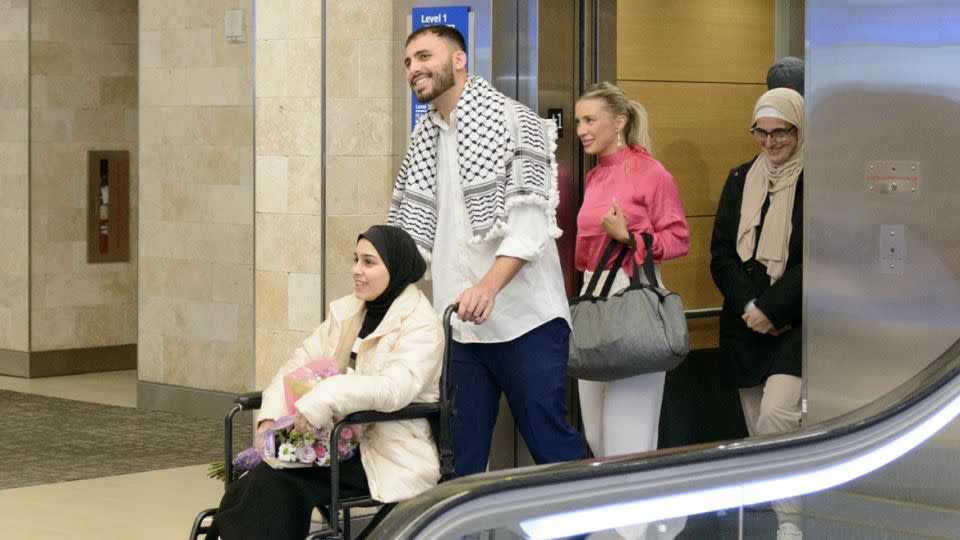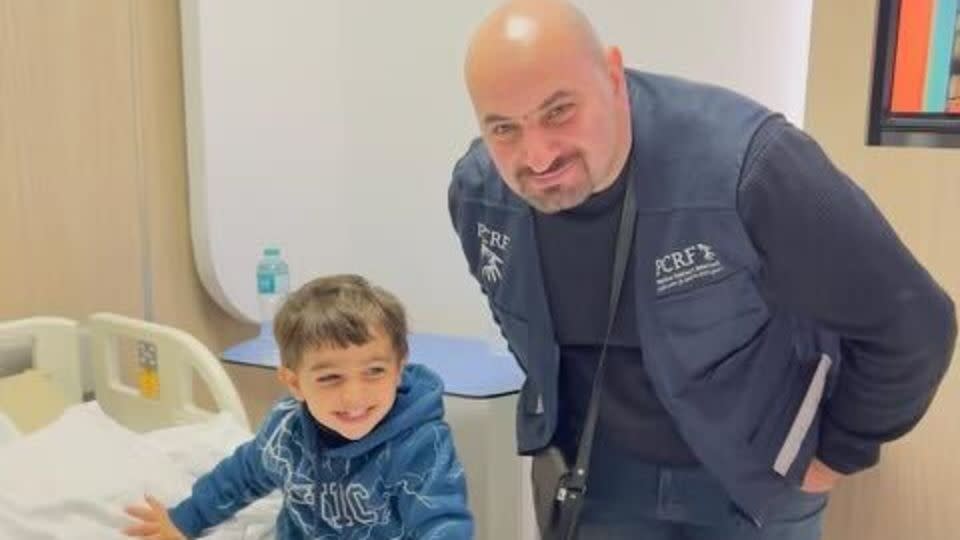Gazan youths with amputated and injured legs find care in the US, but face an uncertain future
Ahed Bseso lay on the kitchen table in her home in northern Gaza, watching as her uncle amputated her injured right leg with a knife. Standing by, her mother cried, “Ahed is dead!”
But 18-year-old Bseso was very much alive, and she has survived to tell her story, from a hospital in Greenville, South Carolina.
Bseso said that on December 19 last year, she went to the top floor of her house in Gaza to get a cellphone signal when an Israeli tank outside fired at her building. It destroyed part of her home’s wall, which came crashing down on her leg, along with heavy debris. With her neighborhood under siege and no possibility of medical attention, her uncle, who used to work as an orthopedic surgeon, used kitchen supplies to amputate her leg below the knee and dress it with unsterilized gauze.
The days that followed were horrifically painful.
“For four days, I couldn’t leave the house because the Israelis wouldn’t let me,” she told CNN through a translator, at the Shriners Children’s hospital. “There was no medication I could take to inhibit the pain or to help me with my condition. So, I just sat in agony for four days.”

The video of her amputation went viral and caught the attention of the Palestine Children’s Relief Fund (PCRF), a US organization that provides free health care to thousands of injured and ill Palestinian children in the Middle East. The organization worked for weeks to evacuate her from northern Gaza and bring her to the United States for medical care, according to Tareq Hailat, head of the Treatment Abroad program at PCRF.
She is one of three Palestinians who received PCRF’s help to come to the US for leg injury treatment.
At least 1,000 children in Gaza have had one or both legs amputated, UNICEF reported in December. Though he couldn’t give an exact figure, UNICEF spokesperson Joe English told CNN that the number has since grown.
Nearly 26,000 children — or just over 2% of Gaza’s child population — were killed or injured in the Gaza Strip in the first six months of the Israel-Hamas war, according to international nongovernmental organization Save the Children. From October 7, 2023 — the date of the Hamas attack on Israel — to early April, more than 13,800 children were killed and at least 12,009 were injured, the organization said.
Avoiding amputations
Two-year-old Jood Damo’s house was struck by a tank shell on December 26 last year, killing his mother and fracturing his right leg.
His father, Ahmed Damo, who accompanied him to the US, told CNN that the toddler witnessed his mother dying. “To this day, he still has episodes where he asks about his mom,” he said. “Sometimes, he wakes up in the middle of the night, just crying and screaming, and asking about his mother.”
Now, doctors at another hospital in Chicago are assessing whether his injured leg will respond to treatment and grow at the same rate as his left leg. If not, it could significantly delay his path to recovery and treatment plan, PCRF said.

Ayham Musalm, 13, said his left leg was fractured and had glass shrapnel lodged in his knee when debris from a strike on a neighbors’ house came straight into his home on December 10. He went months, however, without anyone identifying what was wrong. “I wasn’t able to see any physician for a long time,” he told CNN. “Then one physician just sewed my wound, and said it wasn’t serious and sent me home.”
In the care of Shriners Children’s hospital in Greenville, Musalm has had access to imaging and MRI processes, which helped American experts find the shards of glass inside his knee. That led to surgery and further treatment, and he avoided amputation. He is now in physical therapy.
It took PCRF weeks and sometimes months to get children out of Gaza. Besides the time needed to secure their US visas, evacuating the children — or even moving them from one part of the strip to the other — required Israeli approval, which can be a complicated process, according to Hailat, who works on the evacuations.
This delay in treatment for such injuries can result in grave repercussions, said Dr. Amber Alayyan from Médecins Sans Frontières (Doctors Without Borders), an international aid NGO. “The longer they wait without care, the worse it’s going to be,” she said.
Alayyan, who has traveled in and out of Gaza several times, said the enclave could have handled the care for such injuries before its healthcare system was devastated by the war.
“We see people who, despite their burns, walk into the clinic without a jaw because the healthcare system has completely collapsed and there are no spaces to take care of these people in the hospitals,” she said. “There were 3,500 beds in the hospitals in Gaza before the war. But there are so many displaced people living, squatting, seeking shelter in hospitals, that there’s not even space for the patients.”
“As a result, the wounds that these patients are suffering from are beginning to literally rot,” she added. “They smell now.”
In these overwhelming conditions, doctors are struggling to identify infections and types of injuries, and the focus is entirely on saving lives.
“You wouldn’t necessarily need to carry out these life-saving amputations because you would have had a system that functioned. You would have had reconstructive surgery. Possibly, you would have had immediate lifesaving surgery possible, and they would have been able to save these limbs,” she said. “And now we are doing everything we can just to save lives in the moment.”
PCRF’s Hailat said he doesn’t know if Bseso’s injury required an amputation either. But with Gaza under siege, and no immediate medical attention, hospital care, and sterilized equipment available, amputation was the only choice. When she arrived in the United States, the bone in her other leg was also deeply infected. Doctors feared that she may have needed both legs amputated, but with adequate care and treatment, she has avoided that outcome.
An anxious wait to return home
Evacuating to the United States is not the obvious answer for all injured children, Hailat said. The country has accepted 20 children from Gaza for treatment, but Hailat said he has rerouted 17 of them to other nations.
Some injuries are so severe that Hailat said he has to choose medical care as quickly as possible — which means staying in the region — over expertise and the advanced level of care in the United States.
He also said he wants to ensure that the children who are evacuated to the US need treatment that’s specifically available in the country. “We’re trying to limit how many people we bring to the United States. We would much rather bring people to local areas and local countries around Gaza,” he said. “However, if specific treatment of that particular child is needed to be done in the United States, then we will go out of our way to ensure that happens.
Culture is also important for care and recovery, Hailat said. “Culturally, you don’t want to separate them so far away from their homeland that it’s difficult for them to adapt,” he said. “And I want them to be close to Gaza. This is a very sensitive time, and I don’t want them to feel as though we are separating them from their country.”
Back home, Bseso said her mother fell sick as malnourishment has plagued northern Gaza. She worriedly waits for more news and updates from home, and she knows that her family would be trying to make their way to the top of their residential building, to find a cell signal to contact her — the same ritual that put her in the Israeli line of attack.
Her hope is to reunite with them in a safe place. “We really need our family to be with us together,” she said.
Musalm, too, wants his treatment to finish so he can return to Gaza and see his family.
But there is no knowing when that may be. After their treatments, which Hailat said will most likely take a year, PCRF will ensure it is safe in Gaza before returning the children there. “We will not do that if it puts them in danger,” he said. “So we will have to wait to ensure that Gaza is able to be a safe location for them to return.”
For more CNN news and newsletters create an account at CNN.com

